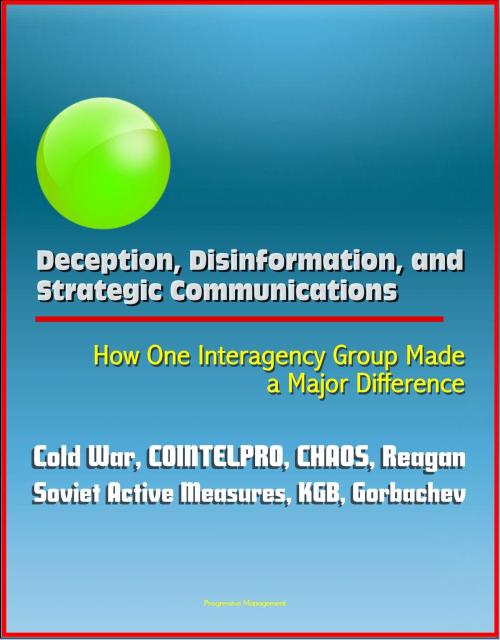Deception, Disinformation, and Strategic Communications: How One Interagency Group Made a Major Difference - Cold War, COINTELPRO, CHAOS, Reagan, Soviet Active Measures, KGB, Gorbachev
Nonfiction, Social & Cultural Studies, Political Science, Government, Communism & Socialism| Author: | Progressive Management | ISBN: | 9781301560479 |
| Publisher: | Progressive Management | Publication: | January 8, 2013 |
| Imprint: | Smashwords Edition | Language: | English |
| Author: | Progressive Management |
| ISBN: | 9781301560479 |
| Publisher: | Progressive Management |
| Publication: | January 8, 2013 |
| Imprint: | Smashwords Edition |
| Language: | English |
This study explains how one part-time interagency committee established in the 1980s to counter Soviet disinformation effectively accomplished its mission. Interagency committees are commonly criticized as ineffective, but the Active Measures Working Group is a notable exception. The group successfully established and executed U.S. policy on responding to Soviet disinformation. It exposed some Soviet covert operations and raised the political cost of others by sensitizing foreign and domestic audiences to how they were being duped. The group's work encouraged allies and made the Soviet Union pay a price for disinformation that reverberated all the way to the top of the Soviet political apparatus. It became the U.S. Government's body of expertise on disinformation and was highly regarded in both Congress and the executive branch.
Some of the topics covered include: Countering disinformation, COINTELPRO, CHAOS, President Ronald Reagan, Gorbachev and Dobrynin, James Angleton, Active Measures Group, Newt Gingrich, KGB, Herbert Romerstein, Stanislas Levchenko, Charles Wick.
The working group also changed the way the United States and Soviet Union viewed disinformation. With constant prodding from the group, the majority position in the U.S. national security bureaucracy moved from believing that Soviet disinformation was inconsequential to believing it was deleterious to U.S. interests—and on occasion could mean the difference in which side prevailed in closely contested foreign policy issues. The working group pursued a sustained campaign to expose Soviet disinformation and helped convince Mikhail Gorbachev that such operations against the United States were counterproductive.
The working group was also efficient. It had a disproportionate impact that far exceeded the costs of manning the group, producing its reports, and disseminating its information overseas. The group exposed Soviet disinformation at little cost to the United States, but negated much of the effort mounted by the large Soviet bureaucracy that produced the multibillion-dollar Soviet disinformation effort. Over time, the working group's activities drove Soviet costs for disinformation production up even further and helped bankrupt the country.
Active Measures and Small Interagency Group Performance * Devaluing the Counter-Disinformation Mission: 1959-1977 * Rebounding to Take the Offensive: 1977-1981 * The "Reagan Revolution" and Countering Soviet Disinformation: Early 1981 * The Founding of the Group: 1981-1984 * Momentum Carries the Working Group: 1984-1985 * The Apogee of the Active Measures Working Group: 1986-1987 * Analysis of Variables Explaining Performance of Active Measures * Working Group * Atrophy and Decline: 1988-1992 * Performance Assessment * Observations
This study explains how one part-time interagency committee established in the 1980s to counter Soviet disinformation effectively accomplished its mission. Interagency committees are commonly criticized as ineffective, but the Active Measures Working Group is a notable exception. The group successfully established and executed U.S. policy on responding to Soviet disinformation. It exposed some Soviet covert operations and raised the political cost of others by sensitizing foreign and domestic audiences to how they were being duped. The group's work encouraged allies and made the Soviet Union pay a price for disinformation that reverberated all the way to the top of the Soviet political apparatus. It became the U.S. Government's body of expertise on disinformation and was highly regarded in both Congress and the executive branch.
Some of the topics covered include: Countering disinformation, COINTELPRO, CHAOS, President Ronald Reagan, Gorbachev and Dobrynin, James Angleton, Active Measures Group, Newt Gingrich, KGB, Herbert Romerstein, Stanislas Levchenko, Charles Wick.
The working group also changed the way the United States and Soviet Union viewed disinformation. With constant prodding from the group, the majority position in the U.S. national security bureaucracy moved from believing that Soviet disinformation was inconsequential to believing it was deleterious to U.S. interests—and on occasion could mean the difference in which side prevailed in closely contested foreign policy issues. The working group pursued a sustained campaign to expose Soviet disinformation and helped convince Mikhail Gorbachev that such operations against the United States were counterproductive.
The working group was also efficient. It had a disproportionate impact that far exceeded the costs of manning the group, producing its reports, and disseminating its information overseas. The group exposed Soviet disinformation at little cost to the United States, but negated much of the effort mounted by the large Soviet bureaucracy that produced the multibillion-dollar Soviet disinformation effort. Over time, the working group's activities drove Soviet costs for disinformation production up even further and helped bankrupt the country.
Active Measures and Small Interagency Group Performance * Devaluing the Counter-Disinformation Mission: 1959-1977 * Rebounding to Take the Offensive: 1977-1981 * The "Reagan Revolution" and Countering Soviet Disinformation: Early 1981 * The Founding of the Group: 1981-1984 * Momentum Carries the Working Group: 1984-1985 * The Apogee of the Active Measures Working Group: 1986-1987 * Analysis of Variables Explaining Performance of Active Measures * Working Group * Atrophy and Decline: 1988-1992 * Performance Assessment * Observations















